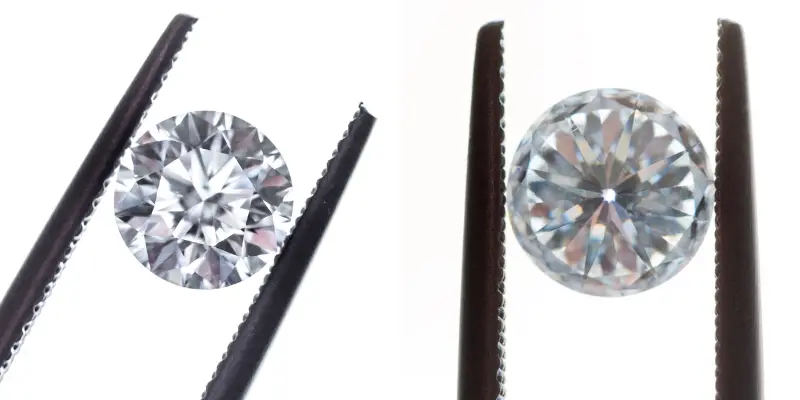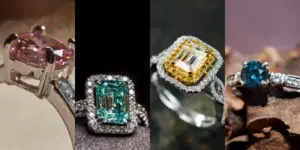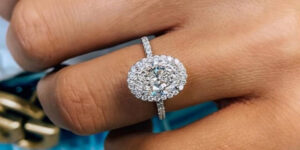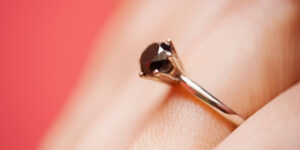Reading a diamond grading report can be confusing sometimes, and the culet is one of the most confusing things on that report. What is a culet and why does it matter ? Should a diamond have a culet in the first place ? How can you check if your diamond has a culet at home ? Do they need extra protection ?
All the facets of a diamond work together to create that mesmerizing play of color and light, and the culet is one of them. SO let’s discuss what the culet is, how to check for it, and what the culet grade means for your diamond.
What is a diamond culet ?
A diamond culet is the pointed tip at the very bottom, where all the facets of the pavilion meet. In round brilliants it looks like the tip of a sharpened pencil, in elongated cuts it can be a single straight line, and in other cuts it can be a single point but at a less sharp angle (such as a marquise or a princess cut).
The diamond culet is there to prevent the light from escaping through the bottom of the diamond. When the culet is closed (or pointed) light bounces off the facets that form the culet, so the diamond will appear brighter. That being said, culets can be closed/pointed, or they can be very tiny. Let us explain.
Diamond culet grading scale
The diamond culet grade on the diamond report will tell you how open the culet is, if it is open at all. An open culet means instead of a perfectly closed point, the pavilion has a very small facets, like the tip was cut off. If there is a culet, it runs perfectly parallel to the table of the diamond, so you can see directly through the diamond.
Culets range from closed to extremely large, with the extremely large ones being 15% or more of the diamond’s diameter. These culets are immediately noticeable. If you’re wondering what size culet is the largest acceptable, it’s the very small one (less than 1.5% of the diameter).

Should a diamond have a culet ?
Modern diamonds should not have a culet, or at least have a very small one that is hard to see when the diamond is face-up (less than 1.5% of the diameter).
Culets can look terrible in modern diamonds. The larger the culet the larger the window directly into the diamond, thus allowing you to see through the diamond. This is not a look most people are going for, since light can escape through the bottom of the diamond and lead to a poor performance.
Another issue is the size of the culet relative to the size of the other facets. Modern diamonds have very small, precise facets. If you’re looking at crushed ice diamonds then you definitely know how tiny and splintery the facets can be. A culet in the middle of such a diamond will be immediately noticeable since it won’t blend into the rest of the facets.
Older diamond cut styles have a culet
Diamond culets were very common in older diamond cuts, such as the old European, or the old mine cut. These cuts offered a very different look from the round brilliant and the cushion cut that we know today. Their facets were larger, fewer, and the culet at the bottom was there to offer protection to the stone.
A culet on a diamond means there are less pointed, extra sharp points that could chip off while the stone is set or worn. So in theory older cut styles with a culet might be a little safer than modern ones. In practice though, a diamond’s culet is rarely hit or chipped or becomes vulnerable when set, especially with modern setting styles and methods.

Modern diamonds do not need a culet anymore, and due to the very different faceting styles available, a culet is too noticeable. Of course the allure of vintage diamond is hard to resist, and we’re not saying old diamonds with a culet are bad. We’re saying the culet is common in these old cuts, and something you should keep in mind. They will sparkle differently than modern diamonds.
Read also: Diamond Cut VS Clarity
How to check if your diamond has a culet at home
The first and simplest way to check if your diamond has a culet is to look at its report. There you should find things such as table height, depth of cut, and where there are inclusions (if any). There should also be a culet section, and a good one should be nonexistent/pointed, or very small. Anything larger than that will be too noticeable and start to affect light performance.
What if you don’t have a certificate for the diamond ? A culet, if it exists, should be noticeable if you hold a loose diamond up to the light, face-up to you. If there is a culet you should see a single dot in the middle of the diamond (or a line, if it’s an emerald cut). Ideally, if the dot is present it should be tiny, barely noticeable, less than 1 millimeter in diameter.
If the light is too much, place the diamond directly onto something colored, with the culet touching the surface (like a black t-shirt or a red scarf). If the culet is present, you will see a single colored dot right in the middle, then the various reflections in the pavilion.

If your diamond is already set, such as in heirloom jewelry, you can try to see the culet if you find a bright, well lit spot. Examples include a window when it’s sunny outside, shining a light directly into the diamond, or standing outside in the early morning or late afternoon (no clouds). Stand with your back towards the light source if possible. Angle the crown of the diamond towards your eyes, and shift the diamond slightly left-right. It won’t be easy to see because of all the sparkle, but if there is a culet you should see a dead zone, very small, right in the middle of the diamond.
Protecting your diamond with a sharp (nonexistent) culet
If you want to know the best way to protect your diamond with a very sharp culet, here’s what we recommend. There is no good or bad way to set a diamond, since each method offers something very different. But there are methods that mean the diamond is much more likely to chip, fall off, break, or otherwise be damaged. You want a setting that will follow the general shape of the pavilion and also provide a layer of metal under it (ideally).
Avoid overly open settings like half-bezel, tension settings
There are so, so, sooo many ways to set a diamond, but the two most open settings ate the half bezel and tension setting. The half bezel setting means there are two bars that run parallel to each other, and hug the diamond girdle. There are two open spots on the girdle, and the culet/pavilion is also open.
Tension settings rely on the tension within the metal band to hold onto the girdle, as if the diamond is floating. There is a very, very small groove cut into each end of the metal, where the girdle should fit snugly.
Both tension and half bezel settings leave a good chunk of the girdle and the entire culet open. This allows a lot of light into the diamond, so it will sparkle more than others. But it also leaves room for the diamond to be damaged while being worn, including the culet.
High setting, such as cathedral, prong, even a bezel works great
Conversely you should be looking for high settings for your diamond if it has a pointed culet. A high setting means the diamond is lifted up and above the ring, sometimes very high. Examples include the ever-popular cathedral setting, the trellis, the basket setting, the hidden halo, the Tiffany, the prong setting (at least 4!), and also the bezel.
The bezel setting is the only one that features a band of metal all around the diamond girdle, and it often hugs the pavilion as it connects to the ring shank.
These settings offer more protection to the pavilion and culet than tension or half-bezel settings.

I’m the main author for jewelrymaterialguide.com. I started this site after we did tons of research before our wedding and noticed that there is information about rings, jewelry, and so on that is really hard to find on the internet.






